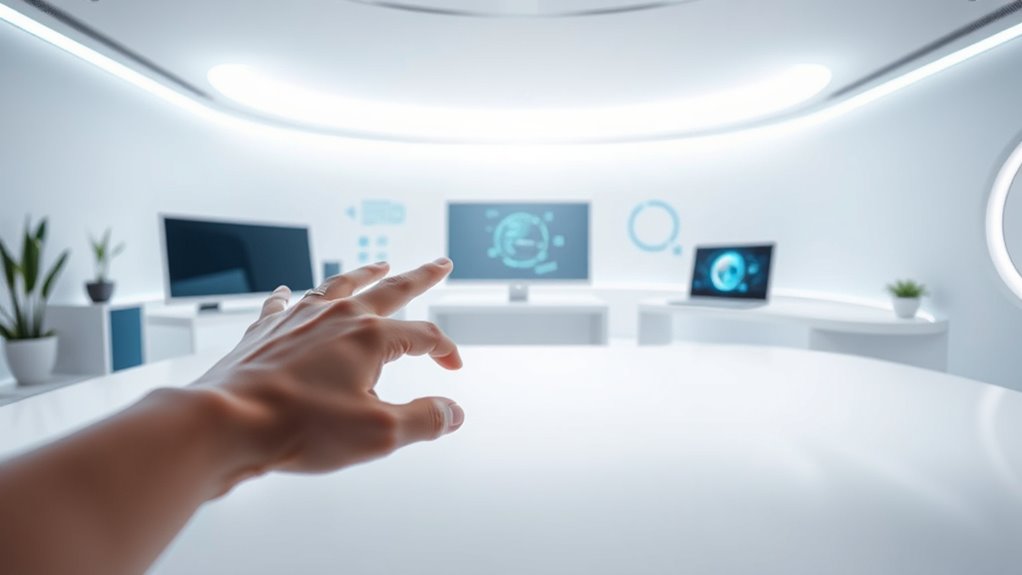Zero‑UI design transforms how you interact with technology by removing visible screens and relying on natural, invisible signals like voice, gestures, and sensors. Instead of manual commands, your environment adapts seamlessly to your habits and context, creating a more intuitive experience. Imagine your devices responding automatically and intuitively without you needing to control or view them directly. To understand how this seamless integration works and how it can change your daily routines, explore further.
Key Takeaways
- Embrace voice, gestures, and sensors as primary interaction methods, reducing reliance on visual screens.
- Develop context-aware systems that adapt seamlessly to user environments and behaviors.
- Prioritize intuitive, invisible interactions that operate effortlessly in the background to enhance user comfort.
- Design with minimal user effort, fostering trust through natural and unobtrusive technology integration.
- Prepare for a future where technology becomes an embedded, invisible extension of daily routines and environments.

Have you ever wondered if technology could become so seamless that you don’t even need to interact with a screen? Imagine a future where your devices anticipate your needs without you having to tap, swipe, or speak explicitly. This is the core idea behind zero‑UI design, where the interface disappears, replaced by natural, intuitive interactions. Instead of relying on visual cues or manual commands, your experience becomes purely sensory—focused on voice interaction, gestures, or even subconscious signals. The goal isn’t to eliminate technology but to embed it so smoothly into your environment that it feels like an extension of yourself.
With zero‑UI, your sensory experience takes center stage. It’s about designing systems that understand and respond to your natural behaviors and environment. Voice interaction becomes the primary way you communicate with your devices. Think about speaking to your smart home to adjust the thermostat, turn on the lights, or play music—without ever opening an app or pressing buttons. Your voice acts as a seamless conduit, making the interaction feel effortless and organic. This approach reduces cognitive load, allowing you to focus on the task rather than the interface itself.
Sensors play an essential role in this ecosystem, constantly gathering data from your surroundings and your body. These sensors might detect your presence, analyze your gestures, or interpret your tone of voice. When combined, they create a rich sensory experience that enables your technology to anticipate your needs. For example, your smart device might notice you’re entering a room and automatically turn on specific lights or start playing your favorite playlist. All of this happens without requiring your direct input, making the interaction feel invisible yet responsive. Incorporating context-aware systems can further enhance this seamless experience by adapting to your changing environment and habits. Additionally, advancements in AI in education suggest that such intuitive interactions could transform learning environments, making them more personalized and adaptive to individual students. Recognizing the importance of sensor integration is crucial for developing truly invisible interfaces that operate intuitively. Furthermore, ongoing research in human-computer interaction emphasizes designing for minimal user effort, which is central to zero‑UI principles.
Designing for zero‑UI isn’t just about adding voice commands or sensors; it’s about creating systems that work invisibly in the background, blending seamlessly into your daily life. It challenges designers to think beyond traditional screens and buttons, focusing instead on context-aware, intuitive interactions. The experience should feel natural, not forced, fostering trust and comfort with technology that truly understands you. As you become more accustomed to these invisible interfaces, your relationship with technology shifts from control to harmony. You don’t need to think about how to operate a device—your environment simply responds to your presence and intentions, creating a more fluid, immersive experience. Zero‑UI design is paving the way for a future where technology is so integrated, it becomes an invisible partner in your daily routines. Moreover, understanding concepts like Glycolic Acid benefits can help enhance your skincare routine without the need for manual application, exemplifying how seamless integration can improve daily life.
Frequently Asked Questions
How Does Zero‑Ui Design Impact User Privacy?
You might wonder how zero‑UI design impacts user privacy. It can enhance data privacy by reducing the amount of personal data collected, since interactions happen seamlessly and invisibly. This approach also promotes user anonymity, as you don’t need to reveal much information to interact with the system. However, it’s essential to guarantee that behind-the-scenes data collection is transparent and secure, maintaining trust and safeguarding your privacy.
What Skills Do Designers Need for Zero‑Ui Development?
Think of zero‑UI design like a symphony where every instrument must work in harmony. You need skills in sensor integration and contextual awareness to create seamless experiences. You should understand how to interpret data from sensors and anticipate user needs without relying on screens. Critical thinking, problem-solving, and an understanding of AI and IoT are essential. These skills help you craft intuitive, invisible interfaces that enhance user interactions effortlessly.
How Do Businesses Measure Success With Zero‑Ui Interfaces?
To measure success with zero‑ui interfaces, you focus on tracking adoption rates and measuring engagement. You analyze how often users interact with the system and whether they achieve their goals efficiently. Monitoring these metrics helps you determine if the interface delivers a seamless experience. You can also gather user feedback and observe behavior patterns, ensuring that the invisible interface truly enhances usability and meets business objectives.
Are There Specific Industries Best Suited for Zero‑Ui?
Think of industries like healthcare and automotive as gardens where zero‑UI thrives, nurturing seamless experience. You’ll find that these sectors benefit from zero‑UI’s promise of enhanced accessibility and sensory adaptation, making technology more inclusive. For instance, in healthcare, hands-free control helps those with disabilities, while in automotive, voice commands allow safer, distraction-free driving. These industries are best suited because they prioritize safety, accessibility, and intuitive interactions that zero‑UI provides naturally.
What Are Common Challenges in Implementing Zero‑Ui Solutions?
When implementing zero‑ui solutions, you often face challenges like ensuring device compatibility across various platforms and hardware. You also need to support user adaptation, as users might resist changing familiar interaction methods. Additionally, designing intuitive experiences without visual interfaces can be complex. To succeed, you must focus on seamless integration and clear voice or gesture commands, making interactions natural and accessible for diverse users and devices.
Conclusion
As you embrace zero‑UI design, remember to focus on fluid functionality and fearless futurism. By fostering familiarity and forging seamless, speechless systems, you’ll foster a future where interfaces are invisible but impactful. Stay savvy, stay supportive, and let simplicity steer your strategy. With a little foresight and finesse, you’ll forge a frictionless, fearless, and fundamentally functional user experience, paving the way for a truly transformative tech tomorrow.









